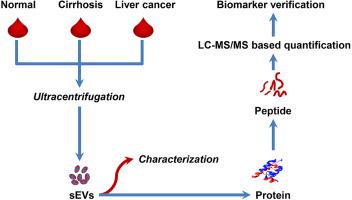Biochimie ( IF 3.9 ) Pub Date : 2020-08-21 , DOI: 10.1016/j.biochi.2020.08.013 Asad Uzzaman 1 , Xuguang Zhang 2 , Zhi Qiao 1 , Hao Zhan 2 , Amir Sohail 1 , Amir Wahid 1 , Zhi Shang 1 , Xin Guan 3 , Cheng-Xi Cao 4 , Hua Xiao 1

|
Hepatocellular carcinoma (HCC) is a common neoplastic transformation of the hepatocytes, which has high morbidity and mortality worldwide, particularly in Eastern Asia. HCC is also developed as a consequence of chronic liver cirrhosis, and both diseases are difficult to diagnosis and differentiate. Accurate noninvasive biomarkers for HCC and cirrhosis are urgently needed. In the search for novel candidates, small extracellular vesicles (sEVs) were isolated from the serum of liver cancer patients, liver cirrhosis patients, healthy control subjects, as well as the culture media of hepatocellular carcinoma cells (HepG2) and normal hepatocyte cells (Lo2). Isolated sEVs were confirmed by size distribution analysis, morphological analysis, and surface biomarker tests. Mass spectrometry based label-free quantification revealed 61 and 63 differentially expressed proteins in the serum sEVs of liver cirrhosis patients and liver cancer patients (p < 0.05), respectively. The proteomics data of cell-derived sEVs were combined for the selection of valuable candidates. Promising proteins were further verified by immunoassay, including thrombospondin-1 (THBS1), fibulin-1(FBLN1), and fibrinogen gamma chain (FGG), which could differentiate healthy control from liver cancer or liver cirrhosis. Our findings verified the hypothesis that cancer-related proteomics signatures are present in the sEVs of patient’s serum and might be monitored for the evaluation of liver cancer and liver cirrhosis.
中文翻译:

从人血清中发现小细胞外囊泡蛋白,以治疗肝硬化和肝癌。
肝细胞癌(HCC)是肝细胞常见的肿瘤性转化,在全世界,尤其是在东亚,其发病率和死亡率很高。由于慢性肝硬化也发展了HCC,并且两种疾病都难以诊断和区分。迫切需要用于肝癌和肝硬化的准确无创生物标志物。在寻找新的候选药物时,从肝癌患者,肝硬化患者,健康对照对象以及肝细胞癌细胞(HepG2)和正常肝细胞细胞(Lo2)的血清中分离出小细胞外囊泡(sEVs)。 )。通过大小分布分析,形态分析和表面生物标志物测试确认分离的sEV。基于质谱的无标记定量分析显示,肝硬化患者和肝癌患者的血清sEV中分别有61和63种差异表达的蛋白(p <0.05)。结合细胞来源的sEV的蛋白质组学数据来选择有价值的候选基因。有前景的蛋白质通过免疫测定得到了进一步验证,包括血小板反应蛋白1(THBS1),纤维蛋白1(FBLN1)和纤维蛋白原γ链(FGG),它们可以将健康控制与肝癌或肝硬化区别开来。我们的发现证实了这样的假设,即患者血清的sEV中存在与癌症相关的蛋白质组学特征,并且可以对其进行监测以评估肝癌和肝硬化。结合细胞来源的sEV的蛋白质组学数据来选择有价值的候选基因。有前景的蛋白质通过免疫测定得到了进一步验证,包括血小板反应蛋白1(THBS1),纤维蛋白1(FBLN1)和纤维蛋白原γ链(FGG),它们可以区分健康对照与肝癌或肝硬化。我们的发现证实了这样的假设,即患者血清的sEV中存在与癌症相关的蛋白质组学特征,并且可以对其进行监测以评估肝癌和肝硬化。结合细胞来源的sEV的蛋白质组学数据来选择有价值的候选基因。有前景的蛋白质通过免疫测定得到了进一步验证,包括血小板反应蛋白1(THBS1),纤维蛋白1(FBLN1)和纤维蛋白原γ链(FGG),它们可以将健康控制与肝癌或肝硬化区别开来。我们的发现证实了这样的假设,即患者血清的sEV中存在与癌症相关的蛋白质组学特征,并且可以对其进行监测以评估肝癌和肝硬化。



























 京公网安备 11010802027423号
京公网安备 11010802027423号